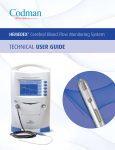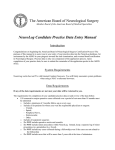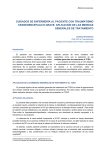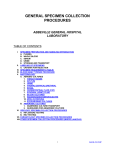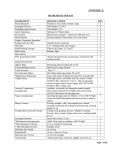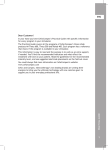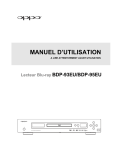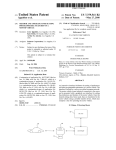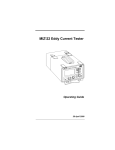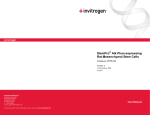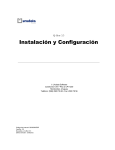Download 1 Know the flow… © Copyright 2006-2011. Hemedex, Inc. All Rights
Transcript
® © Copyright 2006-2011. Hemedex, Inc. All Rights Reserved 1 Know the flow… 2 Know the flow… The purpose of this guide is to aid in the placement and fixation of the QFlow 500™ Perfusion Probes in neurosurgery cases and to help interpret the data recorded by the Bowman Perfusion Monitor™. This BPM Neuromonitoring Guide provides a general technical overview and is not intended to replace the User Manual or IFUs for individual products. For detailed information, please refer to the User Manual of the Bowman Perfusion Monitor and IFU for the QFlow 500 Perfusion Probe. The successful use of the Bowman Perfusion Monitor requires that: The probe is inserted at the appropriate site and to the appropriate depth for the given indication; The probe is kept fixed at this location; The data are properly interpreted. The following sections should aid in this process. This guide is intended for use by anyone involved in the care of neurosurgery patients who are being monitored with the Bowman Perfusion Monitor. Basic knowledge of neuroanatomy and procedures is assumed. Hemedex has developed thermal diffusion technology that continuously and accurately measures real-time absolute blood flow in soft tissue. The Bowman Perfusion Monitor (BPM) system consists of a patient monitor an umbilical cord and a minimally invasive, flexible microprobe measuring 1 mm in diameter. The following is a brief overview of how the BPM system uses thermal diffusion technology to quantify perfusion: The probe is inserted into the target tissue approximately 25 mm below the dura. The surface of the sensor at the tip of the probe is heated a small increment above the tissue baseline temperature; while a second sensor (8 mm proximal to the sensor at the tip) monitors and compensates for baseline tissue temperature changes The total heat transfer from the probe into the tissue consists of a thermal conduction component, represented by the K value, and the thermal convection component, which is related to tissue blood flow. Through multiple complex algorithms and the information from the sensors, the BPM determines the K value and quantifies the absolute blood flow in the spherical volume of tissue interrogated by the sensor at the probe tip. The BMP has a graphical user interface and a thermal printer. A maximum of fifteen days of data can be stored on the hard drive of the monitor. Data can be downloaded to a computer for storage and analysis. 3 Know the flow… (Please refer to the User Manual for complete and detailed instructions) The Bowman Perfusion Monitor is designed as a stand-alone unit for patient bedside use. Perfusion is measured with QFlow 500 probes which must be inserted properly into the target tissue and attached to the monitor. The front panel of the Bowman Perfusion Monitor holds the power switch. Printer, display screen, menu buttons, and umbilical cord connector (for the QFlow 500 probe). To take measurement, a QFlow 500 probe must be appropriately placed in the target tissue, connected to the umbilical cord, and the umbilical cord must be connected to the monitor. The monitor checks for a probe to start the measurement and continues checking to ensure the probe is not disconnected during the measurement. Figure 1 4 Know the flow… The rear panel of the Bowman Perfusion Monitor contains a BNC connector for the analog output and a 9 pin female connector (DB-9) for serial communications (RS-232) to an outboard computer. The rear panel also contains the power cord connector and an indicator showing the power input compatible to the monitor. This is the fuse and line voltage selector. The switch must be set accordingly for the country of use. Figure 2 The printer records the real-time perfusion measurements on paper for review and record keeping. When “Print” option is requested, the data shown on the display screen will be printed with the probe label and the unique probe ID number with option to Print Perfusion; Print Perfusion & Temperature, Print PPA and K Values, or Print Settings. Load paper in the Bowman Perfusion Monitor before operating. The printer uses standard 50mm thermographic print rolls. To load paper in the printer: 1. 2. 3. 4. Open printer access panel by flipping door down. Push black trigger on lower right side to access paper compartment. Insert paper roll into opening with paper coming off the bottom. Close paper door and printer access door. Figure 3 5 Know the flow… The Bowman Perfusion Monitor provides both digital and analog outputs which interface with a number of patient monitors and data acquisition systems. The digital output connects directly to any standard RS-232 serial port. Digital data is streamed through a serial port and can be sent to multimodal monitoring data collection systems or uploaded to a laptop. BPM users have interfaced with a number of digital output systems including the following: ICU Pilot by CMA Microdialysis AB Component Neuromonitoring System by CNS Technologies, LLC Bedmaster by Excel Medical ICM+ by University of Cambridge (UK) BPM users have interfaced with a number of analog output systems including the following: Philips Monitors (using VueLink), by Philips PowerLab by AD Instruments BCI2000 For further questions regarding multi modal monitoring please contact Hemedex. The QFlow 500 Probe is placed in the soft tissue of the brain and is able to quantify perfusion through the use of thermal diffusion. To determine a perfusion measurement the probe must be appropriately placed in the target tissue, connected to the umbilical cord, and the umbilical cord must be connected to the monitor. Each QFlow 500 Probe has 2 thermistors—one at its tip and one 8 mm proximal to the tip. The passive thermistor measures the baseline temperature of the tissue while the active thermistor is heated so that its surface temperature is approximately 2 °C above that of the baseline. The power required to maintain the initial 2 °C temperature elevation varies directly with to the cerebral blood flow (CBF) in the interrogation volume (the spherical interrogation volume has a diameter of approximately 8 mm). The greater the blood flow, the higher the thermal dissipation from the active thermistor and the greater the power required to maintain the 2 °C temperature elevation. Figure 4 6 Know the flow… QFlow 500 probes are inserted similarly to other cerebral probes, i.e. intraparenchymal ICP probes, via a burr hole. The probes can also be tunneled under the scalp. The probe tip should be placed approximately 25 mm below the dura, completely surrounded by tissue and preferably in white matter. The probe should be placed in the vascular territory of interest including: areas at risk for ischemia, areas downstream of a vasospasm, or in any area in which you are interested in measuring CBF. The probe should be placed in a position without cardiac or respiratory pulsatile effects. If too shallow, the proximal temperature sensor can be near or outside the dura and introduce temperature artifact. If too deep, there is risk of probe being placed in the ventrical. The risks associated with implanting the QFlow 500 probe are the same as those associated with implanting other minimally invasive, intraparenchymal probes. Contraindications are the same as catheter insertion into tissue. Histological stides reveal only minimal tissue destruction and no bleeding around insertion track. There have ne no signs of inflammation, edema, or thermal damage to tissue. In compliance with regulatory requirements, the tissue is never heated above 41 ˚C (105.8 ˚F). The QFlow 500 probe is CT compatible and radio opaque. The QFlow 500 probe is not MRI compatible. If the patient needs an MRI, it is necessary to remove the probe. The probe does not need to be “zeroed out” or calibrated like some other catheters. The probe is permanently calibrated at Hemedex and does not require any sort of technical recalibration. The user does not need to do anything to “zero out” the probe. 7 Know the flow… Vajkoczy et al found that in the 16 patients tested, XeCT and BPM perfusion values correlated very well. Ideally, a correlation fit line would have a unity slope and zero intercept. The actual slope found was very close to unity (1.01) and the intercept was very close to zero (-1.56 ml/100 g-min). For this correlation, measurements with both techniques were registered in time and space. The XeCT images were taken from a 5 ml region of white matter surrounding the BPM probe. This study concludes that the focal perfusion probe measured in a 0.3 ml (approximately) volume correlates with regional perfusion measured in a 5 ml volume. The regional perfusion measurement is indicative of the flow in the vascular territory. The Umbilical Cord is used to connect the QFlow 500 Probe to the Bowman Perfusion Monitor. It is 12 feet in length. The umbilical cord must be cleaned and disinfected prior to each use. The umbilical cord will only work with the Bowman Perfusion System. No other cable will connect to either the QFlow 500 Probe or BPM. Take care to ensure the umbilical cord is securely clipped in order to avoid accidental incidents that may damage the umbilical cord. Figure 5 8 Know the flow… 1. Place monitor on shelf or securely mount on IV pole. 2. Plug power cord into back of monitor and opposite end into wall power outlet. When the monitor is not plugged into the wall, or is turned off, it will not lose previously recorded data. The monitor will retain a total 15 days of data. Please note that the monitor does not have battery capabilities. 3. Connect umbilical cord into connector on front left panel of the monitor. The umbilical cord is 12 feet long. Connect the umbilical cord to the appropriately placed QFlow 500 probe. 4. Press ON/OFF switch on front right panel of monitor. 5. The display screen of the monitor should turn on. The message line is on the top of the display screen. 6. Measurement of tissue temperature, PPA, K value, and initial ∆T (during the Temperature Stabilization Phase) will begin automatically. 7. If the probe has been placed appropriately in white matter, perfusion measurement will begin 4 minutes after the automatic calibration process is completed. 8. Perfusion measurement is displayed in absolute units of ml/100g-min. 9. The graphic display shows perfusion measurement in real time. 9 Know the flow… The Bowman Perfusion Monitor is shipped configured to Factory default settings. We strongly suggest that users monitor with these factory defaults left in place. Further, we suggest that any change to the monitor settings is not optimal and we recommend talking to Hemedex prior to changing these settings. Figure 6 ) The Perfusion Change Verifier (PCV) is a feature which forces recalibration to verify in situ calibration parameters if perfusion increases from the baseline by 7.5 ml/100g-min or decreases from the baseline by 5 ml/100gm-min within one perfusion measurement cycle. The factory default setting is PCV “on.” The user may disable this function by pressing the “Options” and then the “Overview Menu” keys. At this point, pressing the “Perf. Change Verifier” key toggles the feature on and off. Users that perform Perfusion Challenges should make sure this feature is turned off for the challenge. 10 Know the flow… The Probe Placement Assistant (PPA) is a feature to aid in optimal placement of the perfusion probe. The Probe Placement Assistant (PPA) gives a measure of the quality of the placement of the probe and therefore the perfusion measurement. PPA is expressed as a number ranging from 0 to 10 and indicates the relative level of pulsatile signal present in the calibration data. A value of 0.0 indicates ideal measurement conditions. A value greater than 5 indicates that the level of artifact in the measurement may be unacceptable. The BPM will not provide perfusion values when the PPA is 5.0 or above. If such is the case, the status bar at the top of the monitor display will instruct the user to reposition the probe. Meanwhile, the monitor will continue to check for an acceptable PPA. To better assist the user, the PPA displays via color and numeric indicators. Green (less than 2) indicates good placement Yellow (2 to 4.9), fair placement Red (5 or greater), generally unacceptable placement In Trend Mode, the monitor is configured to provide short “snapshots” of perfusion, 2 minutes in length, approximately every 15 minutes. Trend Mode forces frequent in situ calibration and thus minimizes the effects of changes in the thermal gradient and in hydration levels during the measurement. It presents the user with maximum frequency of independent perfusion measurements. The factory default setting for Trend Mode is “off.” A fully developed thermal field in the interrogation volume provides the highest level of accuracy in the perfusion calculation. Before this field is fully developed, the perfusion value, as presented in the top left corner of the screen, blinks. This two minute blinking period is referred to as “grayout.” The noted number is approaching that which will be presented when the thermal field is fully developed, and it can be used as a “stat” value. After the “grayout” period, perfusion values are graphed on the screen and the numeric value no longer flashes. Some of features discussed previously are grouped in the Overview Menu which is accessed from the Options Level 1 menu. All other features not found in Overview Menu occur automatically in the phases of the Bowman Perfusion Monitor. 11 Know the flow… The BPM measurement cycle has three phases: temperature stabilization, calibration and perfusion measurement. These transitions happen automatically. It takes 2-7 minutes on average for the monitor to go through the temperature stabilization and calibration phases. During these two phases, no perfusion measurement will be taken. Recalibration happens automatically at the end of the preset perfusion measurement time. The message line at the top of the screen will indicate which phase of the measurement cycle the monitor is in. Figure 7 At the start of each new measurement, the monitor will automatically begin with temperature stabilization phase. During this phase, the monitor is confirming the stability of the tissue baseline temperature, which usually takes several minutes, and no perfusion measurement is taken at this time. If the patient’s temperature is not sufficiently stable, or is undergoing dramatic changes, a warning message will display as “Temp not yet stable – Check Settings – Monitor is trying”; the monitor will continue to check for temperature stability, and no perfusion measurement will be taken. Once the tissue temperature meets the stabilization criteria, the BPM system will continue to the calibration phase. The BPM system calibrates periodically to update the measurement of those tissue parameters which vary with time and have an impact on determination of perfusion. During each calibration the then current tissue parameters of PPA (pulsatility in the interrogation volume) , K (thermal conductivity reflecting changes in tissue hydration/edema), and initial ∆ T (tissue thermal gradient) are quantified. 12 Know the flow… The monitor automatically calibrates during the period immediately after temperature stabilization and before perfusion measurement while the probe is implanted in the target tissue. The monitor has the capability to automatically calibrate within a pre-set time interval ranging every 2 minutes to 2 hours. The default setting in the monitor for re-calibration is every 60 minutes. Recalibration may last 3-5 minutes. During this time, no perfusion measurement is taken. To manually set the Re-Calibration time interval, begin at the START MENU, use arrow keys to adjust time parameters, and press OK to allow the monitor to close out the dialogue box. This means the monitor will automatically recalibrate at the time interval set for the perfusion period. Perfusion measurement begins after the calibration is complete, but no reading appears until 2 minutes later. BPM is capable of detecting cerebral blood perfusion ranging from 0 to 200 ml/100gmin. Perfusion measurements are displayed both numerically and graphically on the screen. These values are updated once per second. The length of the perfusion measurement phase depends on the settings the user has selected. By default, this measurement phase will last up to 60 minutes. At the completion of the perfusion measurement phase, the monitor will return to the temperature stabilization phase. New perfusion measurements will be unavailable until the BPM completes temperature stabilization and calibration again. The user may terminate the perfusion measurement phase by pressing the “Stop” button which discontinues all measurements or by pressing the “Calibration” button which forces the monitor back to the temperature stabilization measurement phase. All BPM measurement phase transitions are made automatically. Under normal conditions, the length of time the monitor operates in each phase will be dependent on the settings the user has selected (perfusion measurements may be set for 2 minutes to 2 hours.) However, the BPM automatically monitors the measurement conditions and may restart the measurement cycle to insure robust data. For example, if probe motion is detected, the monitor will truncate a perfusion measurement phase and return to temperature stabilization. Similarly, if tissue parameters calculated during the calibration stage are outside of the acceptable range, the BPM will return to the temperature stabilization phase and try the measurement again. Perfusion is measured using thermal dilution, so stable temperatures are critical. If the tissue temperature is not sufficiently stable or is elevated such that perfusion measurements cannot be made without exceeding the regulatory limits set for heating tissue, the monitor will remain in the temperature stabilization phase indefinitely. As soon as thermal conditions allow, the BPM will automatically transition to the calibration phase to continue perfusion measurements. To manually set the Re-Calibration time interval, begin at the START MENU, then use arrow keys to adjust time parameters, and press OK to allow the monitor to close out the dialogue box. This means the monitor will automatically recalibrate at the time interval set for the perfusion period. 13 Know the flow… Use the menu on the right hand side of the main screen to control the Bowman Perfusion Monitor, to set measurement and device parameters, and to manage the viewing of data. A menu shows up to five selections at a time. The menus are arranged in a hierarchical tree, so selection of one option often opens a new set of menu items at the next level in the tree. Figure 8 Starts a perfusion measurement. On initial connection of the probe, the monitor starts automatically. Stops a perfusion measurement. This action overrides the measurement control cycle. The monitor takes a few moments to shut down the measurement process. Stored Data option allows the user to “review”, “delete”, or “upload” data. The Bowman Perfusion Monitor saves data automatically with a maximum limit of 15 days. The monitor creates a new perfusion file for each probe. If more than 15 days of data are collected on a single file, the additional data will overwrite beginning at day one. Data can be uploaded to a computer. The stored data is identified with three different tags: 1. The user designated label, which is entered in the Set Label menu. 2. The date of the first use of the probe in the patient. The probe is approved for singlepatient use. 3. The time of the first use of the probe in the patient. For data management support, please contact Hemedex. 14 Know the flow… Press Set Time Range and us up and down arrow buttons to select the time range of horizontal axis. He default value is 15 minutes. Use left and right arrow buttons to scroll the data. Press OK to allow the time range dialog box to close and the plots on the display screen adjust to reflect the time range of the user’s choice. 2. Press Scroll Time and use arrow buttons to select which portion of the data you want to display. 3. Press Set Perfusion Range and use arrow buttons to adjust the upper extend of the perfusion plot shown on the display screen. Press Autoscale to turn ON or OFF autoscale. When autoscale is on, the monitor will automatically adjust the displayed plot to allow for the highest range of perfusion detected. 4. Press Select Plots & List K to view various temperature plots and list of K values. 1. Measure perfusion manually advances to the temperature stabilization phase to expedite perfusion measurement phase. Calibration manually terminates the current perfusion measurement phase and initiates a new measurement cycle of temperature stabilization, calibration, and perfusion measurement. The function of this button toggles between Measure Perfusion and Calibrate depending on the phase of the perfusion measurement cycle on the BPM. Press Print to request printing of data. All printed strips of data include label information and the unique probe ID. Select one of the four options to print data: 1. Print Perfusion: Print the perfusion trace plot that currently appears on the display screen. 2. Print Perfusion & Temperature: Print plots of perfusion and proximal temperature (tissue baseline temperature). 3. Print K and PPA Values: Print all the values recorded for thermal conductivity, PPA, and the time and date they were recorded. 4. Print Settings: Print all the current settings. 15 Know the flow… To restore manufacturer’s defaults, stop all measurements, press Restore Defaults, and then Confirm Restore. Use arrow keys to select Delete old label if appropriate or to enter patient name by pressing OK for each selected character. Choose Label Complete when finished. Be sure to press Return to get back to the main screen. Audio: The Bowman Perfusion Monitor includes audio and visual 1. Press Audio to turn audio alarm ON or OFF. The speaker symbol on the perfusion alarms. When perfusion drops below the alarm display screen brightens or dims. lower bound for a specified period of time, the monitor triggers the alarm. Similarly, when perfusion rises above 2. the alarm upper bound for a specified period of time, the 3. Visual: 4. Press Visual to turn visual alarm ON monitor triggers the alarm. of OFF. The siren symbol on the display screen brightens or dims. To set Upper Bound or Lower Bound for perfusion alarm, the user can set the value of the bound, trigger time, and suspend time. Trigger Time specifies how long measured perfusion must lie outside the bound before the monitor triggers the alarm. Suspend Time specifies how long a triggered alarm remains suspended (temporarily disable) after you acknowledge it. Enable the bound to ensure the activation of the alarm. Return three times to get back to the main screen. Use this option to set the date and time for the monitor. Use arrow keys to adjust time parameters. Once the time parameters are set the monitor will automatically re-calibrate at the interval user set for the perfusion period. Re-Calibration generally takes 3-5 minutes at which time no perfusion measurement will be taken. On the display screen the breaks in the perfusion vs. time graph represent these re-calibrations. 16 Know the flow… Use arrow keys to adjust baud rate parameters. Contact Hemedex for assistance in using RESEARCH SETTINGS and ADVANCED SETTINGS. Figure 7 17 Know the flow… Proper probe insertion requires consideration of the following: The probe measures focal perfusion in a volume of approximately (0.27ml) 0.3cc. This focal measurement, in absolute units (ml/100mg/min), represents the cerebral blood flow delivered by the supplying vasculature to that territory. Placement should be made into the tissue or vascular territory of interest. The probe uses a thermal technique for the quantification of perfusion. The measurement may be affected by rapid changes in tissue temperature (irrigation, rapid infusion of fluids, etc.). Relative probe/tissue motion will cause artifact and possibly recalibration if severe enough. The probe should be properly fixed to the bolt or sutured to the scalp. It is good practice to mark or record the initial position of the probe using the cm reference markers to know if it is subsequently inadvertently moved. In order to maximize the diagnostic information, the probe should be placed in a frontal lobe in tissue that is most at risk for secondary, ischemic injury. Care should be taken to insure that the probe is not placed in a contusion, infarct, or a hematoma. It is suggested that the probe be placed ipsilateral to the primary injury, in viable tissue. A CT scan should be taken to insure the probe is properly placed. Based on neurosurgeon preference, however, the probe may be placed contralateral to the primary contusion to monitor the less affected hemisphere. 18 Know the flow… For patients with subarachnoid hemorrhage (SAH), Fisher Grade III, IV or V, a probe should be placed in the vascular territory most at risk for vasospasm. Site Vascular Territory Suggested Probe Implantation Site ICA MCA, ACA MCA MCA ACA ACA ipsilateral ACA contralateral AcomA ACA ipsilateral ACA contralateral Ipsilateral to aneurysm 10 mm anterior to the coronal suture 60 mm lateral to midline Ipsilateral to aneurysm 10 mm anterior to the coronal suture 60 mm lateral to midline Ipsilateral or contralateral to aneurysm 10 mm anterior to the coronal suture 20 mm lateral to midline Ipsilateral or contralateral to aneurysm 10 mm anterior to the coronal suture 20 mm lateral to midline Figure 8 19 Know the flow… 1. Create burr hole Shave, prep, and drape the insertion site using aseptic technique. Mark the insertion site with a marking pen and ruler. Consider injecting the area with a local anesthetic. Use the #15 blade/scalpel to make a linear incision 2 – 3 cm long and carried to the bone. Use the self-retaining retractor to provide bone exposure. Prepare drill according to manufacturer’s instruction. Drill through the outer and inner tables of the skull taking care to minimize any potential for damage to the dura or underlying structures. If necessary, use sterile saline to flush the site for better visibility. Make a cruciate incision, in the dura using a #11 blade/scalpel or bipolar, securing hemostatis as necessary. If the opening in the dura is not sufficient, the probe will not properly track into the cerebral tissue. Visually confirm that there are no obstructions to probe insertion on the tissue surface. Insert the cranial bolt. Follow manufacturer’s instructions. Be sure to attach the compression cap for the QFlow 500 Probe. 2. Insert probe Remove QFlow 500 Probe from package. Be sure to mark the probe for adequate depth insertion. Feed the probe through the corresponding port of the bolt, being careful not to bend the rigid tip of the probe. Using the centimeter markings on the probe, glide the probe to a depth of 25 mm subdurally into the target (white matter) tissue. Make sure to account for any space left between the end of the bolt and the dura. 3. Before breaking the sterile field, confirm adequate placement of the probe by checking the PPA and K Values. 20 Know the flow… 4. Secure the bolt locking mechanism as described by bolt manufacturer. 5. Be sure to position the umbilical cord using the attached clips in such a fashion to prevent accidents, minimize movement and keep the probe connector away from fluids. Figure 9: Insertion of the QFlow 500 Perfusion Probe fixed with bolt. 21 Know the flow… 1. Create burr hole Shave and prep the determined site and exit area (for tunneling) using aseptic technique. Drape the shaved, prepped area. Mark the incision site with a marking pen and ruler. Consider injecting the area with a local anesthetic. Use the #15 blade/scalpel to make a linear incision 2 – 3 cm long and carried to the bone. Use the self-retaining retractor to expose bone Prepare drill according to manufacturer’s instruction. Using a 2.7 mm twist drill, drill through the outer and inner tables of the skull taking care to prevent any damage to the dura or underlying structures. If necessary, use sterile saline to flush the site for better visibility. Make an incision in the dura using a # 11 blade/scalpel or bipolar, securing hemostasis as necessary. Visually confirm that there are no obstructions to probe insertion. 2. Create tunnel Use a 14 gauge Tuohy needle to tunnel the probe under the scalp by inserting the needle into incision site and moving under the scalp to exit 6 cm from scalp incision. Remove and discard any trocar. Pass the Probe tip into distal end of needle (exit site) and out proximal end (incision site); slide the needle from the Probe and discard. The needle cannot slide over the blue connector at the end of the probe. Therefore, it is necessary to feed the needle from inside the incision site out towards the exit site. 3. Insert probe Using the centime markings on the Probe as a guide, insert the probe to a depth of 25 mm subdurally into the target (white matter) tissue. Before breaking the sterile field, confirm adequate placement of the probe by checking PPA and K Value. After confirming placement with good PPA and K Value, allow measurement to continue and suture dura and scalp as necessary. 4. Clean and dry the Probe site. 22 Know the flow… 5. Attach Hemedex Fixation Disk If desired, attach the probe shaft to the scalp using the Hemedex Fixation Disk (Catalog Number 3600). Position the disk onto the Probe via the slit (as described in the Disk instructions for use). Slide the Disk onto the scalp and secure Disk in place with sutures. Close the clamp completely, ensuring that the Probe is still adequately positioned (25 mm deep, subdurally). If necessary, apply adhesive dressing. 6. Loop 4-5 cm of probe slack in a circle around the probe exit site and secure shaft to scalp with three (3) sutures spaced evenly apart. 7. Apply appropriate dressing to burr hole and probe exit site. 8. If appropriate, tape the blue probe connector to the patient’s neck or shoulder to minimize movement. 9. Be sure to position the umbilical cord using the attached clips in such a fashion to prevent accidents, minimize movement and keep the probe umbilical cord connection away from fluids. Fluid can travel down the surface of the probe and collect at this connection. Figure 10: Insertion of the QFlow 500 Perfusion Probe via burr hole and tunneled. 23 Know the flow… Before breaking the sterile field, confirm adequate placement of the probe by checking the K and PPA Values. Connect the probe to the umbilical cord and Monitor and the measurement will automatically start. After a few minutes, the Monitor will go into calibration and display PPA, K Value, and initial ∆T. If the probe is not in a good location you will receive an error message, “High PPA value—Suggest repositioning perfusion probe”. If you have a high PPA Value (>5.0), move the probe 1 mm by either pulling it back or advancing it if conditions allow. If you have a PPA value between 2 and 5 with a yellow background, we suggest you try moving the probe in small steps to get the PPA value down below 2. A good K Value will fall between 4.8 and 5.9. Another way to ensure proper depth placement is with a CT scan. The probe is radiopaque and, although depth markings do not appear on a CT scan, the probe does, which permits viewing of the probes position in brain tissue. 24 Know the flow… The Bowman Perfusion Monitor automatically suspends measuring perfusion when the tissue temperature reaches 39.5 °C or above. Perfusion measurement is automatically resumed when the tissue temperature drops below this level. The device is designed to operate in this way because the FDA mandates that tissue must not be heated above 41 °C. The probe will heat the tissue up by 1 °C above the baseline of 39.5 °C. This leaves a safety factor of 0.5 °C. The probe does contain a reference temperature sensor that permits the monitor to compensate the signal for changes in patient temperature. However, when the tissue temperature changes rapidly, this may induce drift in the temperature difference or gradient between the two sensors and correspondingly in the perfusion measurement. Any drift in perfusion measurement is corrected at the next recalibration. If the temperature gradient between the sensors does not change the monitor provides accurate measurements through large changes in tissue temperature. Figure 11: CBF measurement artifact during 03:00 to 03:10 as a result of an abrupt cerebral tissue temperature decrease of 0.2 °C in 5 minutes (temperature data not shown). Note that the recalibration and the subsequent CBF values displayed after 03:20 show that CBF was most likely steady the entire time from 03:00 to 03:20. 25 Know the flow… Probe motion causes an artifact in the measurement with an apparent and characteristic spike upward in perfusion measurement. This is caused by the fact that the distal sensor must rapidly reestablish the thermal field in the tissue at the site where the sensor has been translated to. If the perfusion measurement does not return to the pre-motion level, the monitor will automatically recalibrate. These spikes are examples of micromovements that are sometimes the result of patient seizures. They can also be caused by small tugs on an unsecured umbilical cord. A number of these micro movements can cumulatively result in the probe moving from white or gray matter or even being moved to the extent that the proximal sensor is not deep enough in the tissue to get reliable readings. It is good practice to record the initial position of the probe using the cm reference markers to know if it was inadvertently moved. For small motion, the CBF value returns to its level prior to the motion. In the event that the CBF does not return to its pre-motion level, the BPM will automatically recalibrate. Clips are provided with the umbilical cord to secure it so the weight of the cord does not tug on the probe and move it. Figure 12 The probe can migrate if it is not adequately fixed. If a probe migrates, it must develop a new thermal field on which to report perfusion. If this new position is less than optimal (e.g. adjacent to a pulsating vessel), then the probe should be repositioned in order to collect accurate perfusion data. (Probe migration can occur in a comatose patient if care is not taken when the patient is moved by staff (e.g. for bathing, to change bedding, etc.). 26 Know the flow… Proper probe insertion requires consideration of the following: The probe measures focal perfusion in a volume of approximately (0.27ml) 0.3cc. This focal measurement, in absolute units (ml/100mg/min), represents the cerebral blood flow delivered by the supplying vasculature to that territory. Placement should be made into the tissue or vascular territory of interest. The probe uses a thermal technique for the quantification of perfusion. The measurement may be affected by rapid changes in tissue temperature (irrigation, rapid infusion of fluids, etc.). Relative probe/tissue motion will cause artifact and possibly recalibration if severe enough. The probe should be properly fixed to the bolt or sutured to the scalp. It is good practice to mark or record the initial position of the probe using the cm reference markers to know if it is subsequently inadvertently moved. According to the published article “Continuous Monitoring of Regional Cerebral Blood Flow during Temporary Arterial Occlusion in Aneurysm Surgery,” by Thomé, Vajkoczy, Horn et al (J. Neurosurg./Volume 95/September, 2001), the implantation site of the bolt was chosen according to the vascular territory of interest parasagitally, either 2 cm lateral to the midline for aneurysms of ACD or 6 cm lateral to the midline for aneurysms of the MCA or ICA. The probe should be inserted in the vascular territory determined by the neurosurgical clinician to be most affected by the bypass, to assess the adequacy of flow. 27 Know the flow… Figure 13 shows a rendition of the placement of the probe though a burr hole adjacent to the craniotomy. In the event that post-operative monitoring is desired, it is best to forward tunnel the probe. The procedural steps for the probe placement with tunneling are as follows: 1. Create Burr Hole At the site for probe insertion, use a scalpel with a #15 blade to make a linear incision 23 cm long and carry it to the bone. Use a self-retaining retractor to provide bone exposure. Using a 2.7 mm drill bit, drill through the outer and inner tables of the skull taking care to minimize any potential for damage to the dura or the underlying structures. If necessary, use a sterile flush to enhance visibility. Make an incision in the dura using a #11 blade or bipolar, securing hemostasis as necessary. 2. Create Tunnel Use a 14-gauge Tuohy needle to tunnel the probe under the scalp by inserting the needle from the site of the burr hole, under the scalp to exit at the desired location approximately 6 cm from the burr hole. Remove any trocar that may be in the needle lumen. Pass the probe tip through the lumen in the distal end of the Tuohy needle and advance the probe tip toward the burr hole. While holding the probe in place, slide the Tuohy needle out from under the scalp and discard. 3. Insert Probe Using the blue centimeter markings on the probe shaft as a guide, insert the probe through the burr hole to a depth of 25 mm below the level of the dura into the white matter. Suture scalp over burr hole as necessary. Loop 4-5 cm of probe slack in a circle around the site where the probe exits from under the scalp and secure the probe shaft with three sutures spaced evenly apart. Figure 13: Drawing of the QFlow 500 Probe placed via a burr hole and tunneled adjacent to a craniotomy. Note in the insert, the centimeter (cm) spaced markings, with a double mark at 5 cm from the tip. There are also larger solid marks at 10 cm and an additional mark at 2.5 cm that are not visible here. 28 Know the flow… Based on neurosurgeon preference, the intra-operative placement of the probe through a burr hole may not be desirable. In this case, the probe may still be placed through an open craniotomy. However, extra care must be taken to position the probe at the edge of the craniotomy away from the main surgery site to minimize artifact from retraction, irrigation and mechanical interference. In the event that post-operative monitoring is desired, it is best to forward tunnel the probe. Also make sure to insert the probe through the site of one of the burr holes that was used to create the craniotomy. In this way, when the bone flap is put back in place, there will be an opening for the probe shaft to exit. The procedural steps for the probe placement through a craniotomy with tunneling are as follows: 1. Create Tunnel Use a 14-gauge Tuohy needle to tunnel the probe under the scalp by inserting the needle from the edge of the craniotomy, under the scalp to exit at the desired location approximately 6 cm away. Remove any trocar that may be in the needle lumen. Pass the probe tip through the lumen in the distal end of the Tuohy needle and advance the probe tip toward the craniotomy. While holding the probe in place, slide the Tuohy needle out from under the scalp and discard. 2. Insert Probe Using the blue centimeter markings on the probe shaft as a guide, insert the probe to a depth of 25 mm below the level of the dura into the white matter. Loop 4-5 cm of probe slack in a circle around the site where the probe exits from under the scalp and secure the probe shaft with three sutures spaced evenly apart. Confirm adequate placement of the probe by checking the PPA and K values. The needle cannot slide over the blue connector at the end of the probe. Therefore, it is necessary to feed the needle from inside the incision site out towards the exit site. Figure 14: The placement of the QFlow 500 Perfusion Probe via a craniotomy and tunneled. 29 Know the flow… Confirm adequate placement of the probe by checking the PPA and K Values. Connect the probe to the umbilical cord and Monitor and the measurement will automatically begin. After about 3 minutes, the Monitor will go into calibration and display PPA and K Values. If the probe is in a location where it is affected by pulsatile motion you will receive an error message, “High PPA value—Suggest reposition perfusion probe”. If you have a high PPA Value (>5.0), move the probe 1 mm by either pulling it back or advancing it if conditions allow. If you have a PPA value between 2 and 5 with a yellow background, we suggest you try moving the probe in small steps to get the PPA value down below 2. After confirming placement with a good PPA value and a good K Value (4.8 < K < 5.9), allow the measurement to continue and fix the probe and umbilical cord to the drape. During intra-operative procedures, the measurement of perfusion may be affected by the following: Thermal instability from tissue cooling via the open craniotomy Thermal instability from fluid irrigation Probe/tissue relative motion from tissue retraction Reduced perfusion from tissue compression via retraction Probe motion from external interference or patient seizures Electrocautery interference, especially unipolar (i.e., Bovie) Based on these considerations, it is recommended that the probe be inserted though a burr hole just adjacent to the craniotomy to reduce thermal and mechanical interference to the probe. Tissue irrigation close to the entry location of the probe may cause thermal instability in the reading and prevent an accurate measurement of blood flow and/or induce a longer stabilization time. 30 Know the flow… Retraction can affect the measurement by: 1. Inducing the cerebral tissue to move relative to the probe, thus causing a motion artifact 2. By decreasing the blood flow by compression of the tissue behind the retractor. Therefore it is suggested that the probe be placed away from the site of retraction. Electrocautery, both unipolar (Bovie) and bipolar, can cause electrical interference with the Monitor. This interference can introduce noise into the perfusion data and possibly cause the monitor to automatically recalibrate. The operation of the device should return to normal, as soon as the electrocautery ceases. Automatic recalibration Start of bipolar Figure 15: Interference in the perfusion measurement from bipolar. Probe movement may be caused by retraction or by external interference with the probe shaft. Linear movement of the probe along the insertion track causes a characteristic artifactual spike in the perfusion measurement. This is recognized by the Monitor which then produces an error message. If the motion is significant enough, the monitor will automatically recalibrate. Small patient seizures can sometime cause tiny probe movements that cumulatively can cause the probe to be withdrawn. Noting the initial position of the probe relative to the printed cm markings, can aid in noticing these subtle probe movements over time. Also paying attention to the Δ Temp during the time that the monitor indicates “Temperature Stabilization…” can also help indicate that the probe might have moved closer to the surface. The magnitude of Δ Temp should typically be under 0.400° C. 31 Know the flow… The CT scan (left) shows that the CBF Probe is placed at the proper depth (25 mm below the dura). In this case, the probe is inserted into the ACA vascular territory in an SAH patient on day 1 post hemorrhage. Figure 16: The BPM shows the white matter cerebral blood flow (CBF) is steady at approximately 25 ml/min-100 g and the K value is 5.423 (normal range 4.89 to 5.98). The CT scan (right) shows the CBF probe misplaced subdurally. Figure 17: The BPM shows the artifactual CBF measurement as a result of the probe tip placed subdurally. Note the significant variability and a subnormal level of flow. The K value is high, approximately 6.5. 32 Know the flow… CT scan (left) shows that the CBF probe is misplaced into the ventricle. Ventricular Drain CBF Probe Figure 18: The BPM shows the artifactual CBF data for this probe while it was in the ventricle. Note the significant and artifactual variation in CBF over the 5minute measurement window. These artifactual variations in CBF measurement are caused by respiration and heart rate induced CSF fluid motion around the probe tip in the ventricle. Also, in this case, the K value is slightly higher than normal (5.932). . The CT scans show that the probe is inserted too deep (41 mm below the dura). Normally, the probe should be 2-2.5 cm below the dura. At such a depth, cardiac and respiration induced brain motion cause the CBF measurement to artifactually fluctuate due to small amounts of probe-tissue relative motion. This also causes the K value to be artifactually high (6.194). CBF Probe tip Ventricular Drain tip Ventricular Drain CBF Probe Figure 19: The BPM shows the corresponding artifactual CBF measurements. 33 Know the flow… 34 Know the flow… Figure 20: Normal white flow matter is between 20 and 35 ml/100g-min. The PPA value is green and the K value is between 4.8 and 5.9. CBF waveform shows stable trend and averages about 28 ml/100g-min overall. 35 Know the flow… The Bowman Perfusion Monitor alerts clinicians in real-time to the onset of vasospasm allowing early intervention before permanent damage. Any cause of SAH including TBI can trigger vasospasm. About 30,000 persons are diagnosed with a ruptured brain aneurysm every year in the U.S. Cerebral vasospasm leads to death or serious disability in about 20 % of ruptured brain areurysms. The prevalence of TBI is much greater. Figure 21: The Bowman Perfusion Monitor above shows 12 hours of CBF measurements taken in an SAH patient during the onset of vasospasm. The data is approximately 4 days after aneurysm rupture. Vasospasm with CBF below 15 ml/min-100 g is seen at approximately 10:30 AM with CBF going below 15 ml/min-100 g. The diagnosis of vasospasm was independently confirmed with a perfusion CT scan (figure 22) taken on October 15 at 14:30 and a neurological exam. CBF deficit Figure 22: The diagnosis of vasospasm was independently confirmed with a perfusion CT scan (taken on Oct. 15 at 14:30) and a neurological exam. Courtesy of Dr. Stephan B. Lewis, University of Florida 36 Know the flow… Cerebral vasospasm remains a major problem in patients recovering after surgical treatment of cerebral aneurysms or traumatic brain injury. The BPM allows real-time detection of vasospasm. It demonstrates in real-time: the effect of pharmaceutical and adjunctive therapy on the restoration of flow allows the clinician to determine the effectiveness of the therapy reduces the decision burden on the clinician helps the clinician determine the appropriate times at which expensive global imaging technologies should be applied. Figure 23: Papaverine is a potent vasodilator that has been proposed to counteract vasospasm in patients with subarachnoid hemorrhage. In 2001, Vajkoczy, using continuous BPM CBF measurements generated a detailed dose-response curve to IAP that show the benefits of IAP in treating vasospasm are transient. Figure 24: Follow-up measurements demonstrated that 12-hour CBF is not significantly different from the pre IAP baseline. The BPM can be used to validate alternative therapeutic strategies to improve cerebral blood flow in patients with cerebral vasospasm. 37 Know the flow… Nimodipine is indicated for the improvement of neurological outcome by reducing the incidence and severity of ischemic deficits in patients with subarachnoid hemorrhage. Nimodipine given Figure 25: While nimodipine is known to slightly decrease mean arterial pressure (MAP), it was thought to not adversely affect CBF Figure 25 (top) shows a screen shot taken from the monitor of CBF during the administration of nimodipine. Note the sharp and sudden decrease in CBF along with the corresponding decrease in mean arterial pressure (MAP) and cerebral perfusion pressure (CPP) in Figure 26 (below). CBF and CPP return to baseline values after 30 minutes. This effect was repeatable with each dose of the drug. 130 Figure 26: Wolf, et al., 2009 studied the use of continuous intraarterial infusion of nimodipine in patients with refractory cerebral vasospasm. They found that the Hemedex rCBF measurement was the most effective technique for monitoring the impact of nimodipine. The authors conclude that continuous infusion of nimodipine may be beneficial for specific patients and that CBF monitoring should be employed with the infusion of nimodipine. MAP Pressure [ mm Hg ] 120 CPP 110 100 90 80 70 14:00 14:30 15:00 38 Know the flow… Figure 27: The annotated view of the BPM shows 30 minutes of intra-operative CBF measurements made in the MCA vascular territory during an EC/IC bypass using the saphenous vein to connect the common carotid artery (CCA) to the MCA. Note the hyperemia after the release of the bypass clamp and the subsequent establishment of a new and higher CBF level. 39 Know the flow… Temporary arterial occlusion (TAO) during aneurysm surgery carries the risk of ischemic sequelae. Because monitoring of regional cerebral blood flow (rCBF) may limit neurological damage, Thome, et..al. evaluated the BPM for use in the continuous and quantitative assessment of rCBF during TAO. Occlusion-induced ischemia is reliably detected within the 1st minute after clip application. This capability may enable the surgeon to alter the surgical strategy early after TAO to prevent ischemic brain injury. Figure 28: The waveform above illustrates typical CBF during a TAO clipping procedure. The perfusion baseline is first established before placing the temporary clip (at approximately 19:51) when an immediate reduction of CBF is seen. Illustrated is the rather high collateral flow and for this patient a subsequent recruitment of capillaries. At approximately 19:59 the temporary clip is removed; the BPM then shows reactive hyperemia followed by return to baseline perfusion. 40 Know the flow… Figure 29: Claudius Thomé Study: 20 patient population CBF measurements recorded before TAO clip, during TAO clip, and after TAO clip Figure 30: Using the data collected, Thomé calculated a Hypoperfusion Index (HPI) for each patient: HPI = Time/Flow Of the 20 patients followed, the 17 patients with a HPI below the indicated threshold did not experience infarct. Using this data, Thomé concluded that the maximum time in which the TAO clip should be in place could be calculated using the following equation: HPI * Flow = Time (For Surgery) 41 Know the flow… Reduction in CBF is one of the major causes of secondary cerebral ischemia in the damaged or edematous brain. The cerebral vascular is exquisitely sensitive to CO2, changing 3 –4% mm Hg in PaCO2., the loss of CO2 reactivity is generally associated with a poor prognosis. Courtesy of Professor Susan Margulies and Professor Stuart Friess, University of Pennsylvania Figure 31: This waveform illustrates the responsivity of the BPM System and CBF to a CO2 challenge. Here a 7.0 kg piglet, intubated and ventilated with 50% oxygen (to avoid hypoxemia during hypoventilation), anesthetized with 0.5% isoflurane and fentanyl infusion 50 mcg/kg/hr, mean arterial pressure ranging between 53 and 56 mm Hg was presented with the following ventilator changes at the indicated times. 13:55 ventilator rate set at 18; Baseline perfusion is 40 ml/100 gm-min 13:59 ventilator rate changed from 18 to 5; Near immediate response in CBF , no further ventilator changes until 14:10. A few spontaneous breaths were observed at 14:02-14:03 which may have affected the CO2 and the CBF. 14:10 ventilator rate changed to 30 14:16 ventilator rate changed to 25 14:20 ventilator rate changed to 18 14:24 ventilator rate changed to 22 42 Know the flow… The probe does contain a reference temperature sensor that permits the monitor to compensate the signal for changes in patient temperature. However, when the tissue temperature changes direction, this may induce artifact in the temperature difference or gradient between the two sensors and correspondingly in the perfusion measurement. Any artifact in perfusion measurement is corrected at the next recalibration. Figure 32: CBF measurement artifact during 03:00 to 03:10 as a result of an abrupt cerebral tissue temperature decrease of 0.2 °C in 5 minutes (temperature data not shown). Note that the recalibration and the subsequent CBF values displayed after 03:20 show that CBF was most likely steady he entire time from 03:00 to 03:20. Note that the recalibration and the subsequent values displayed after 03:20 show that CBF was most likely steady the entire time from 03:00 to 03: 20. 43 Know the flow… Probe motion causes an artifact in the measurement with an apparent and characteristic spike upward in perfusion measurement. This is caused by the fact that the distal sensor must rapidly reestablish the thermal field in the tissue at the site where the sensor has been translated to. If the perfusion measurement does not return to the pre-motion level, the monitor will automatically recalibrate for new tissue conditions. Figure 33: Motion Artifacts (at 14:52:10 and 14:52:38) which temporarily cause the CBF measurement to artifactually increase. For small motion, the CBF value returns to its level prior to motion. In the event the CBF does not return to its pre-motion level, the monitor will automatically recalibrate. 44 Know the flow… The probe may be purposely (or inadvertantly) repositioned in the tissue. Purposefully in instances when one seeks to avoid the presence of cardiac induced brain tissue pulsations in the thermal interrogation volume of the thermal CBF probe; these pulsations can cause artifact in the calculation of thermal conductivity, K. Inadvertant probe repositioning (via migration) can result if the probe is not securely fixed in position and there is patient movement, external tugs on the catheter, seizures, etc. Figure 34: This 8 hour record illustrates a case where the probe was initially placed in gray matter (CBF 55 to 70 ml/100g-min, higher K values, with PPA values of 3-4 (not shown)). At 15:00 the CBF probe was subsequently moved to white matter (CBF of 20 to 35 ml/100g-min, lower K values, with PPA values of zero (not shown)). The higher vascular volume associated with the higher CBF in gray matter contributes to the greater thermal conductivity , K, as tissue thermal conductivity is a function of tissue water content. The K values for both gray and white matter are within the 4.8 to 5.9 range. The values of perfusion and K both before and after probe reposition are typical of probe movement from gray to white matter. 45 Know the flow… 46 Know the flow… Figure 35: (Top) is a plot of the thermal conductivity (k) values calculated at the beginning of each 15 min perfusion measurement run. The early runs all have PPA’s of 10. The perfusion probe was repositioned on 2/13 at approximately 20:00 to a site without measureable pulsatility and thus no pulsatile induced artifact in K (see the reduced value of K and the high level of reproducibility). As perfusion is rather steady (Fig 35(middle)) the increase in K is not a consequence of increased vascular volume but likely due to extra-vascular water … edema. (Middle)demonstrates the value of probe placement in non pulsatile brain capillary bed. The insert illustrates an extreme case that contrasts high PPA versus zero PPA perfusion data. Low PPA perfusion data is characterized by a high degree of reproducibility; high PPA perfusion data can be erratic. (Bottom) is a record of the brain temperature through out the monitoring period. This patient was cooled to approximately 34.8 °C. At approximately 10:00 on 2/15 the patient was re-warmed. The steady perfusion values during the 2 hour re-warming period demonstrates the ability of the BPM to accurately track perfusion through large temperature changes. The inset captures the last 3 (high PPA = 10) and the first 6 (zero PPA) perfusion runs of 2/13 after the probe was repositioned to avoid the artifact in k (thus perfusion) associated with the higher PPA’s. 47 Know the flow… The Bowman Perfusion Monitor automatically suspends perfusion measurement when the tissue temperature reaches 39.5 C or above. Perfusion measurements is automatically resumed when the tissue temperature drops below this level. The device is designed to operate in this manner because of regulations that tissue is not to be heated above 41 C. The probe heats the tissue a minimum of 1 C, leaving a safety factor. Figure 36 : The waveforms illustrate the operation of the BPM when tissue temperature exceeds 39.5 °C. 48 Know the flow… The probe tip can become situated in infarcted tissue by: being inserted into a pre-existing infarction or being enveloped by a growing infarction. Figure 37: The BPM shows the corresponding CBF measured by this probe while it is situated in infarcted white matter tissue. Note the low CBF (below 10 ml/min-100g), though the K value is normal (5.644). Infarction Ventricular Drain CBF Probe Figure 38: The CT scan shows the CBF probe tip placed in infarcted tissue. 49 Know the flow… CBF is normally maintained at a relatively constant level by cerebrovascular autoregulation of CVR over a wide range of CPP values. Auto- regulation of CVR can become dysfuntional (impaired autoregulation) in certain pathologic states such as stroke and trauma when the brain becomes exquisitely sensitive to even minor changes in CPP. Impaired autoregulation is associated with poor outcomes. CPP Pbt02 rCBF C02-EX Courtesy of Dr. Stephan Mayer and Dr. Sang-Bae Ko, Columbia University Presbyterian Hospital Figure 39: This CBF waveform shows approximately 4 hours of rCBF(BPM) and CPP data from a patient in a state of impaired cerebral autoregulation. The rCBF clearly tracks with CPP throughout the entire data set. Each one hour CBF run is followed by a “recalibration” in which certain tissue parameters which change with time are reestablished; namely, tissue thermal conductivity (a function of tissue water content) and the tissue temperature gradient. The periodic requantification of these time varying tissue parameters is important in assuring quality CBF data. Note that the second CBF run ends at approximately 20:43 (hours: minutes) at a value of 41 ml/100 gm-min and at approximately 20:47 the CCP falls dramatically from 120 to about 94 mmHg. The third CBF run which starts at approximately 20:49 at a value of 20 ml/100 gm-min picks up the dramatic drop in CBF associated with the drop in CPP. CPP and CBF track each other as they both eventually bottom out and recover. An hour later at ~21:52 there is another “recalibration” and a seamless pickup of the perfusion data. 50 Know the flow… Sense Temp ( C) Perfusion (ml/100 g-min) Km (mW/cm- C) Recent studies indicating that the ischemic brain is sensitive to minor variations in temperature and has created new interest in hypothermia and brain temperature. Date Courtesy of Dr. Stephan Mayer and Dr. Sang-Bae Ko, Columbia University Presbyterian Hospital Figure 40: A 6.5 day record of thermal conductivity (K), perfusion, and temperature during brain tissue cooling for ICP control. Notice hyperemia on re-warming. The increase in k during 7/1 to 7/2 (low, stable CBF) is due to edema. The further increase in k from 7/3 on reflect higher tissue water from increased vascular volume. 51 Know the flow… “Real-time continuous measurement of brain physiological parameters is increasingly available through multimodality monitoring (MMM). Continuous recording of cerebral physiology include intracortical electroencephalography (ICE), brain tissue oxygen tension (PbtO2) and regional CBF, and microdialysis provides hourly measurements of extracellular metabolites such as glucose, lactate, and pyruvate. While MMM has been used mostly in comatose patients with severe traumatic brain injury, subarachnoid hemorrhage, and intracerebral hemorrhage, its use is currently expanding to include patients with cardiac arrest and status epilepticus (SE).” The MMM graphs show strong correlation between seizure and hemodyamic parameters. Figure 41: Shows the real-time relationship of patient physiological parameters As EEG monitoring was initiated, high power electrical activity was observed suggesting seizure. For the entire duration of the seizure periods, sudden surges in CBF and drops in PbtO2 were repeated. Microdialysis data showed high lactate/pyruvate ratio, suggesting metabolic disturbance. As lorazepam and levetiracetam was administered (arrow), the seizure activity disappeared. Grey bar indicated the more detailed time frame shown in Figure 42. 52 Know the flow… Repetitive electrographic seizure activity detected at the start of monitoring was associated with dramatic reductions in brain tissue oxygen tension and striking surges in cerebral blood flow and brain temperature. Intravenous lorazepam and levetiracetam resulted in immediate cessation of the seizures and these associated derangements. Lactate/pyruvate ratio was initially elevated and trended down after administration of anticonvulsants. Figure 42: This waveform shows the relationship of physiological variables with quantitative EEG parameter during seizure events. During the repetitive seizure events PbtO2 consistently decreased followed by a surge in intracrainial pressure, brain temperature, and cerebral blood flow. In addition total power on the EEG is well synchronized with the rhythmicity index and the existence of high frequency waves in the spectrogram, suggesting a seizure rhythm. The authors conclude that brain multimodality monitoring is a feasible method for evaluating secondary brain injury associated with seizure activity after cardiac arrest. 53 Know the flow… Depolarisations are hypothesised, but have not yet been conclusively proven, to be an independent predictor of poor clinical outcome. CSD manifests itself as periodic waves of depressed electrical activity that spread in the cerebral cortex, along with associated changes in temperature, perfusion, and other important tissue parameters. Because of the unusual character of the slowly moving temperature waves, typically a few mm/min, the magnitudes of the thermally derived perfusion changes may not be accurate, but a pattern of recurrent stereotyped, complex changes in apparent perfusion MAY indicate the presence of CSDs, which is important information on the status of the patient. Courtesy of Dr. A Strong, King's College London, UK Figure 43: The data illustrate the time course of the Hemedex perfusion output in a recent patient with multiple, periodic cortical spreading depression /depolarisation (CSD) episodes (EcoG, not shown), in which each perfusion event was time-locked to a depolarisation. The figures illustrate research in progress and are not intended to suggest that use of perfusion monitoring is standard-of-care. 54 Know the flow… Courtesy of Dr. Jed Hartings, University of Cincinnati Figure 44: Periodic perfusion changes associated with multiple CSDs in a second patient. The onsets of slow potential changes of CSD (ECoG, not shown) are indicated by black arrows, which are followed in a fixed time interval by perfusion decreases (onset indicated by dashed lines). Depolarisations (CSD) sometimes occur without any change in heat clearance signal and when present, perfusion changes may vary considerably as illustrated. Thus ECoG monitoring with a subdural electrode strip remains the gold standard for CSD detection. 55 Know the flow… 1. How do you insert the QFlow 500 Probe? a. Similar to other cerebral probes, i.e. intraparenchymal ICP probes, which are inserted via a burr hole. b. The probes can also be tunneled under the scalp. 2. Where do you implant the QFlow 500 Probe? a. The probe should be placed in the vascular territory of interest: i. In areas which are at risk for ischemia. ii. In areas downstream of a vasospasm. iii. In any area in which you are interested in measuring Cerebral Blood Flow (CBF). b. The probe tip, should be completely surrounded by tissue, preferably white matter. 3. What risks are there in implanting the QFlow 500 Probe ? a. Risks are the same as those associated with implanting other minimally invasive, intraparenchymal probes. b. Contraindications are the same as catheter insertion into tissue. c. Histological studies reveal only minimal tissue destruction and no bleeding around insertion track. d. There have been no signs of inflammation, edema, or thermal damage to tissue. In compliance with regulatory requirements, the tissue is never heated above 41 ˚C (105.8 ˚F). 4. At what depth should the QFlow 500 Probe tip be placed? The probe tip should be placed approximately 25 mm below the dura. This generally insures that the probe tip is in white matter. Markings on the probe aid in placement and can be used to assess if the probe has moved after the initial placement. 5. How do I know I have the QFlow 500 Probe in a good location? When you have a good PPA (less than 2), followed by good K value (4.8 – 5.9) , and a good delta T. 6. What happens if the probe/umbilical cord connection gets wet? How do you keep it from getting wet? How do I determine if the probe/cable connection is wet? How do I fix it? The connection between the probe and umbilical cord is water resistant but not water proof. If the connection sits in a pool of liquid, the liquid may eventually wick into the electrical connections. Care should be taken when the probe is disconnected to prevent fluid from splashing onto the contacts of either connector. If moisture does get in, the connections can be dried out and monitoring resumed. 7. Does the focal measurement reflect the regional blood flow? The regional perfusion measurement is indicative of the flow in the vascular territory. 56 Know the flow… 8. What is the maximum time a QFlow 500 Probe can be left in situ? The probe is indicated for 10 days implantation. 9. Are the QFlow 500 Probes reusable? No, the QFlow 500 Probe is a disposable, single-patient-use item. 10. Is the QFlow 500 Probe MRI or CT compatible? a. The QFlow 500 Probe is CT compatible and radio opaque. b. The QFlow 500 Probe is not MRI compatible. 11. Besides, perfusion, what else does the BPM tell me? a. Tissue temperature: i. in the process of measuring perfusion, the BPM measures baseline tissue temperature near the tip of the probe (the proximal sensor). b. Tissue thermal conductivity (K): i. the K Value, when PPA is zero, is a function of tissue water content and may be an indication of edema. 12. Can the BPM accommodate more than one probe? The BPM is a single channel device. If you want to simultaneously monitor more than one patient (each with their own probe), you will need additional BPMs. Alternatively, multiple probes could be used at alternating intervals with a single BPM. Data is automatically stored to the correct file based on the probe ID. 13. Can the BPM interface with other patient monitors? The BPM provides both analog and digital outputs which interface with a number of patient monitors and data acquisition systems. 14. How much data can be stored/retrieved? When the monitor collects data at a rate of once per second (1 Hz) there is enough memory to store the data for 15 days. 15. Does the Probe need to be calibrated or “zeroed out”? No, the probe does not need to be “zeroed out” or calibrated like some other catheters. TThe probe is permanently calibrated at Hemedex and does not require any sort of technical recalibration . The user, therefore, does not need to do anything to ”zero out” the probe. 16. At the time of insertion, how long do I have to wait for the BPM System to give PPA, K values, and an initial perfusion reading? It takes 2-7 minutes to acheive temperature stability and for the probe heating to calculate the K and PPA values. It takes approximately 4 minutes following probe heating for the temperature field to develop sufficiently for perfusion measurements. 57 Know the flow… 17. What are the short periodic gaps in the perfusion data? The BPM “recalibrates” on a set period which accounts for the gaps in the data. In a recalibration cycle, the BPM shuts off power to the probe allowing the tissue to return to its baseline temperature. After this cool down period the monitor will start a new cycle of perfusion monitoring which includes determining the then current tissue parameters. 18. Why does the BPM system recalibrate? How long does recalibration take? The BPM system recalibrates to periodically update those tissue parameters which vary with time and have an impact on determination of perfusion. The recalibration phase lasts between 2 and 7 minutes. The length of this recalibration period varies depending on the level of CBF. The lower the CBF, the more slowly heat dissipates and the longer it will take to complete the recalibration. Conversely, the higher the CBF, the faster the heat dissipates the shorter the recalibration period. 19. Does the BPM have alarms? Yes, BPM alarms can be set to sound if perfusion reaches above or below a certain threshold for a user-defined time period (i.e., a quick “spike” above or below the alarm thresholds will not set off the alarm). The alarms are not enabled by default; they must be enabled and limits must be set by the user. 20. What can you print? You have the option to print the following: a. Print perfusion b. Print perfusion and temperature (on the same strip) c. Print a list of the K and PPA Values d. Print the current BPM settings. 21. Can the data be smoothed? No, the BPM does not smooth data. The time range can be adjusted so that the data can be compressed or expanded over time, which allows for more detailed viewing at specific points in time. 22. Can average or mean perfusion values be displayed or printed? a. Yes, the BPM displays and prints averaged perfusion values when in Trend Mode. In Trend Mode, the monitor is configured to provide “snapshots” of averaged perfusion, 2 minutes in length, approximately every 15 minutes. b. In Continuous Mode, the BPM displays perfusion values in real time only and does not have the capability to display a mean or average CBF value. 23. What is the correlation between CBF and ICP, CPP, MAP, etc.? a. If pressure autoregulation is intact then you should expect to see CBF stay constant regardless of MAP changes within a certain range. However, in a traumatized brain or following certain vasodilator agents, CBF may become blood pressure dependent. This means the autoregulation mechanism has been compromised and, as a result, CBF will increase as arterial pressure rises, causing an increase in cerebral volume. b. The increase in cerebral volume will cause an increase in ICP. Conversely, without autoregulation, if MAP decreases so does CBF, causing a decrease in blood volume and, eventually, a decrease in ICP. 58 Know the flow… 24. Can I determine if the probe is responsive to a change in perfusion, either on insertion or on a daily basis? Yes, any procedure or challenge which is known to induce a perfusion change can be used to demonstrate the responsiveness of the probe. These challenges can be pharmaceutical, CO2, change in respiration rate, et cetera. 25. What is the Perfusion Change Verifier and what does it do? Are there times it should not be used? The Perfusion Change Verifier is a user selectable feature designed to provide greater data integrity. This feature will automatically recalibrate if the perfusion value increases by 7.5 ml/100g-min or decreases by 5 ml/100g-min within one perfusion measurement cycle. This recalibration is to verify that the perfusion change is either real or induced by a change in tissue thermal conditions, primarily the tissue temperature gradient between the two sensors. When the PCV feature is enabled, recalibration is automatic. 26. I am interested in performing Perfusion Challenges. Is there anything I should be aware of before I do them? a. Check the time remaining in the perfusion measurement period. (This is indicated in the status bar at the top of the screen.) Make sure there is a sufficient amount of time remaining to complete the challenge before the next recalibration period. If you don’t have enough time, you can extend the perfusion period mid-cycle. It is good practice to manually calibrate at the end of one challenge before starting the next one. b. Perfusion Change Verifier (PCV) should be turned off for challenges. When you have completed the challenge, turn PCV on again for unattended monitoring. 27. What routine checks should I make at the start of patient monitoring? a. Before you connect a new probe check the available data storage space (in days). b. See the user manual (available on the Hemedex website) for instructions on uploading collected data that you would like to preserve, and then deleting that data from the BPM. c. Check the time in the lower right hand corner of the BPM display screen to insure that it is synchronized with your main time source. 59 Know the flow… Measurement Cycle Message Error CBF > 50ml/min-100g Possible Causes Probe may be in gray or mixed gray/white matter Patient may be hyperemic CBF < 10ml/min-100g CBF Measurement CBF varies ± 10ml/min100g with respiration rate and /or heart rate Possible Solutions Verify probe is at an appropriate depth (2.5 cm subdural) Confirm probe location with CT Patient may be in vasospasm Probe may be in infarcted tissue Probe may be too deep Probe may be in the ventricle Verify probe is at an appropriate depth (2.5 cm subdural) Confirm probe location with CT Probe may be epidural CBF varies ±10 ml/min100g over minute(s) CBF artifact Measurement Cycle Message Error Slow variations may be due to impaired autoregulation Compare CBF variations with ICP, CPP, and MAP variations Changes in temperature gradient between tissue calibrations Activate PCV or manually recalibrate Possible Causes Tissue temperature changing at rate greater than stability criteria Temperature not yet stable - monitor is retrying [+x.xxx] Temperature Stabilization Probe not deep enough Damp umbilical to probe connection Probe not deep enough Temp gradient too high for perfusion measurement [x.xxx] Paitent temp too high for perfusion measurement (x) [xxxxx:x.xxx] Probe is epidural Damp umbilical to probe connection Fever above 39.5° C Possible Solutions Wait BPM will automatically check stability every 30 seconds Verify probe is at an appropriate depth (2.5 cm subdural) Separate connection and dry electrical contacts on umbilcial and probe using Bair Hugger or air source Verify probe is at an appropriate depth (2.5 cm subdural) Confirm probe location with CT Separate connection and dry electrical contacts on umbilcial and probe using Bair Hugger or air source When patient temperature goes below 39.5° C CBF measurement will automatically restart 60 Know the flow… Measurement Cycle Message Error Possible Causes Probe pulled out of tissue Low K value - make sure probe is in tissue • 4.8 > K > 2, probe likely pulled into bolt Possible Solutions Verify probe is at an appropriate depth (2.5 cm subdural) • K < 1.5, probe in air Pulsatility present in probe interrogation volume Probe may be too deep Probe may be in the ventricle Probe may be sub/epidural High PPA - suggest prepositiong probe (x) [x.xxx] Calibration Probe may be near a vessel Probe motion Damp umbilical to probe connection Probe may be too deep High K value - suggest repositioning probe Probe may be in the ventricle Probe may be sub/epidural Probe may be near a vessel Measurement Cycle Temp discontinuity, check probe and umbilical cord (x) [x.xxx] Damp umbilical to probe connection Temperature change during calibration [x.xxx] Damp umbilical to probe connection Message Error Possible Causes Probe insufficiently secured Patient may be having seizures Unscheduled Recalibrations during Perfusion Measurement Probe may have moved recalibration (xx) [x:x.xxx] Relative probe tissue motion BPM will automatically recalibrate tissue parameters, if problem persists then: • Verify probe is at an appropriate depth (2.5 cm subdural) • Move the probe about 1 mm along the insertion track • Confirm probe location with CT Separate connection and dry electrical contacts on umbilcial and probe using Bair Hugger or air source • Verify probe is at an appropriate depth (2.5 cm subdural) • Move the probe about 1 mm along the insertion track • Confirm probe location with CT Separate connection and dry electrical contacts on umbilcial and probe using Bair Hugger or air source Separate connection and dry electrical contacts on umbilcial and probe using Bair Huggar or air source. Possible Solutions Verify probe is at an appropriate depth (2.5 cm subdural) Baseline temperature drifted - recalibratin [x.xxx] Temperature change of greater than 1 degree during perfusion period Assure appropriate probe strain relief , secure umbilical cord in a position that does not pull on probe Monitor automatically recalibrates tissue parameters Recalibrating to verify perfusion change [x.x] Perfusion Change Verifier (PCV) is on Deactivate PCV for perfusion challenges. Moving the patient Electrocautery Interference 61 Know the flow… S. Wolf, H. Martin, J. F. Landscheidt, S.O. Rodiek, L. Schürer and C. B. Lumenta. "Continuous Selective Intraarterial Infusion of Nimodipine for Therapy of Refractory Cerebral Vasospasm." Neurocritical Care. December 2009. Strong AJ.” Spreading depolarisations: tsunamis in the injured brain (review)”. 2009. Advances in Clinical Neuroscience and Rehabilitation. (1): 32-34 Jens Soukup, Isa Bramsiepe, Matthias Brucke, Lhaghava Sanchin and Matthias Menzel. "Evaluation of a Bedside Monitor of Regional CBF as a Measure of CO2 Reactivity in Neurosurgical Intensive Care Patients." Journal of Neurosurgical Anesthesiology. 20(4): 249-255. October 2008. O.W. Sakowitz, K.L. Krajewksi, D. Haux, B. Orakcioglu, A.W. Unterberg and K.L. Kiening. "Quantification of Transient Ischemic and Metabolic Events in Patients after Subarachnoid Haemorrage." Acta Neurochirurgica, Supplement. 104: 395–397. 2008. Jaeger M, Soehle M, Schuhmann MU, Winkler D, Meixensberger J., “Correlation of continuously monitored regional cerebral blood flow and brain tissue oxygen”, Acta Neurochir (Wien); Jan; 147(1):51-6; 2005.Elke Muench, Peter Horn, Christian Bauhuf, Harry Roth, Mark Philipps, Peter Hermann, Michael Quintel, Peter Schmiedek and Peter Vajkoczy. "Effects of Hypervolemia and Hypertension on Regional Cerebral Blood Flow, Intracranial Pressure, and Brain Tissue Oxygenation after Subarachnoid Hemorrhage." Critical Care Medicine. 35(8): 1844-1851. August 2007. M.Barth, H.-H.Capelle, E.Munich, C.Thome, F.Fielder, P.Schmiedek, P.Vajkoczy, "Effects of the selective endothelin A (ETa) receptor antagonist Clazosentan on cerebral perfusion and cerebral oxygenation following severe subarachnoid hemorrhage - preliminary results from a randomized clinical series", Acta Neurochirurgica, Aug. 2007. J.C. Hemphill, M.M. Knudson, N. Derugin, D. Morabito, and G.T. Manley, “Carbon dioxide reactivity and pressure autoregulation of brain tissue oxygen,” Neurosurgery, 48(2):377-384, 2001.Dirk Henze Matthias Menzel, Jens Soukup, Alexander Scharf, Carsten Holz, Norbert Németh, Frank Hanisch and Tobias Clausen. "Endothelin-1 and Cerebral Blood Flow in a Porcine Model." Journal of Clinical Neuroscience. 14(7): 650-657. July 2007. Muench E, Bauhuf C, Roth H, Horn P, Phillips M, Marquetant N, Quintel M, Vajkoczy P., “Effects of positive end-expiratory pressure on regional cerebral blood flow, intracranial pressure, and brain tissue oxygenation”, Critical Care Medicine; 33(10):2367-72, 2005. Clausen T, Scharf A, Menzel M, Soukup J, Holz C, Rieger A, Hanisch F, Brath E, Nemeth N, Miko I, Vajkoczy P, Radke J, Henze D., “Influence of moderate and profound hyperventilation on cerebral blood flow, oxygenation and metabolism”, Brain Research; Sep 3; 1019(1-2):113-23, 2004. P. Vajkoczy, P. Horn, C. Thomé, E. Munch, and P. Schmiedek “Regional cerebral blood flow monitoring in the diagnosis of delayed ischemia following aneurismal subarachnoid hemorrhage,” Journal of Neurosurgery, 98:1227-1234, 2003. 62 Know the flow… C. Thomé, P. Vajkoczy, P. Horn, C. Bauhuf, U. Hübner, and P. Schmiedek, “Continuous monitoring of regional cerebral blood flow during temporary arterial occlusion in aneurysm surgery,” Journal of Neurosurgery, 95(3):402-411, 2001. P. Horn, P. Vajkoczy, C. Thomé, E. Muench, L. Schilling, P. Schmiedek, "Xenon-induced flow activation in patients with cerebral insult who undergo xenon-enhanced ct blood flow studies", AJNR Am J Neuroradiol 2001 Sep;22(8):1543-9. P. Horn, P. Vajkoczy, C. Thomé, M. Quintel, H. Roth, L. Schilling, P. Schmiedek, “Effects of 30% stable xenon on regional cerebral blood flow in patients with intracranial pathology,” Keio Journal of Medicine, 49(1): A161-163, 2000. P. Vajkoczy, U. Hubner, P. Horn, C. Bauhuf, C. Thome, L. Schilling, and P. Schmiedek, “Intrathecal sodium nitroprusside improves cerebral blood flow and oxygenation in refractory cerebral vasospasm and ischemia in humans,” Letter to the Editor, Stroke, 31:1195-1197, 2000. P. Vajkoczy, H. Roth, P. Horn, T. Luecke, C. Thomé, U. Huebner, G.T. Martin, C. Zappletal, E. Klar, L. Schilling, and P. Schmiedek, “Continuous monitoring of regional cerebral blood flow—Experimental and clinical validation of a novel thermal diffusion microprobe,” Journal of Neurosurgery, 93:265274, 2000. See the Hemedex website for an updated list. 63 Know the flow… Rev: H44000015, Revision C Know the flow… 64
































































